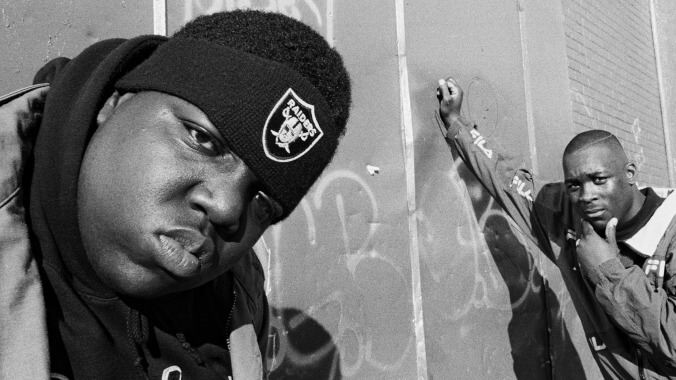Netflix’s Biggie: I Got A Story To Tell spotlights the personal side of the rapper’s life

Perhaps the most jaw-dropping revelation in Biggie: I Got A Story To Tell, the new Netflix documentary on slain rapper Christopher “The Notorious B.I.G.” Wallace, arrives mere minutes into the film. There’s video footage of Wallace on tour, circa 1995. He’s decked out in Mecca gear, hanging out with his crew—better known as Junior M.A.F.I.A.—outside before a big show, when a voice from behind the camera tells him, “Hit that note for me we’ve been hitting all day.” And then Biggie effortlessly belts the first two lines from Jodeci’s sexual-chocolate hit “Freek’n You,” getting frontman K-Ci Hailey’s hellafied, church-bred vocals down damn-near perfectly. That’s when it hits you: Holy shit! The Notorious B.I.G. could sing.
Biggie immediately establishes that we’ll get to see a more honest, personal side of the late MC. The movie begins with a stream of camcorder footage, catching Wallace as he tours all over the place in ’95, riding high off the success of his debut album, Ready To Die (a.k.a. the record that saved East Coast hip-hop), and smash hits like “Juicy” and “Big Poppa.” There are glimpses of a lighter, more playful attitude—joking around and partying with his buddies—that Wallace adopted when not in Biggie mode. It comes out during a filmed interview where the rapper (probably under the influence of some decent weed) answers questions in a lackadaisical, indifferent manner. “Christopher Wallace is a conscious person,” says Damion “D-Roc” Butler, childhood friend and tour videographer, at one point. “He knows what the hell is going on. Notorious B.I.G., he didn’t really give a fuck.”
Without a doubt, Wallace was more comfortable with his boys, and Biggie serves as an origin story on how his rise to hip-hop stardom took not just him but also his people out of the projects. Before stardom, he was the snazzy-voiced MC CWest. He managed to capture his flow thanks to hanging out with jazz artist/neighborhood mentor Donald Harrison, as they would both listen to Max Roach records and see if Wallace could create vocal rhythms out of Roach’s melodic solos. There was also his time with Uncle Dave back in Jamaica, a singer who would take Wallace to clubs so he could listen to his uncle riff over reggae beats. Eventually, Wallace became the crown jewel of Sean “Puffy” Combs’ Bad Boy Records; among the collaborators interviewed for the film, Combs reminisces about thanking God for bringing this physically/vocally husky orator into his life. (Since Combs also serves as executive producer, Wallace’s Bad Boy hits are thankfully on the soundtrack.)
It was clear early on to everyone that Wallace, who had to go by Notorious B.I.G. because white-Latinx rapper Biggy Smallz sent him cease-and-desist letters (even though both of them got the name from the Sidney Poitier/Bill Cosby movie Let’s Do It Again), was nice on the mic. But the future superstar knew that making a living off of that would be a long shot. So he went around the corner from the St. James Place home he shared with his momma, Voletta, and became a drug dealer on Fulton Street. It’s a hustle that everyone in his life, including Combs, his pals, his mother (who went in his room once and threw out a plate of unpackaged crack she thought was dried-up mashed potatoes), and even his fellow partners-in-slangin’, wished he’d concentrate less on—especially after a longtime friend got killed on the job.
Most people already know the sad, sordid details of how Wallace was tragically killed in 1997, at the age of 24—a murder that remains unsolved, just like that of Wallace’s friend-turned-archnemesis Tupac Shakur. And maybe because there’s a whole other documentary about the murders, 2002’s Biggie And Tupac, this one doesn’t heavily concentrate on the rapper’s death. (In fact, all that doesn’t pop up until the last 15 minutes or so.) Instead, director Emmett Malloy, one half of the music video-directing duo The Malloys, takes you back to his early days and how Biggie and his potnas—many interviewed for the film at Brooklyn locales—briefly got out of the ’hood. The future looked bright and they were all on cloud nine. What Biggie shows is that, for one beautiful moment in time, these Brooklyn brothas were enjoying the ride, mainly because they had a talented star as their captain.